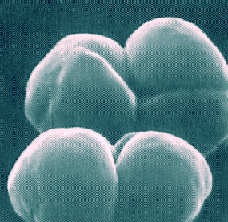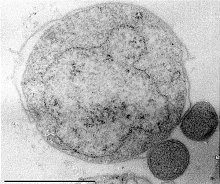Chrysiogenaceae is a family of bacteria.
The Thermoprotei is a class of the Thermoproteota.

In taxonomy, the Thermoplasmata are a class of the Euryarchaeota.

In taxonomy, the Thermoplasmataceae are a family of the Thermoplasmatales. It contains only one genus, Thermoplasma. All species within Thermoplasmataceae are thermoacidophiles, and they grow at a temperature of 60 °C and pH 2. They were isolated from hydrothermal vents, fumaroles and similar environments.

In taxonomy, the Thermoplasmatales are an order of the Thermoplasmata. All are acidophiles, growing optimally at pH below 2. Picrophilus is currently the most acidophilic of all known organisms, being capable of growing at a pH of -0.06. Many of these organisms do not contain a cell wall, although this is not true in the case of Picrophilus. Most members of the Thermotoplasmata are thermophilic.
In taxonomy, the Picrophilaceae are a family of microbes within Thermoplasmatales.

In the taxonomy of microorganisms, the Methanomicrobia are a class of the Euryarchaeota.

Acidilobales are an order of archaea in the class Thermoprotei.
Methanobacteriales is an order of archaeans in the class Methanobacteria. Species within this order differ from other methanogens in that they can use fewer catabolic substrates and have distinct morphological characteristics, lipid compositions, and RNA sequences. Their cell walls are composed of pseudomurein. Most species are Gram-positive with rod-shaped bodies and some can form long filaments. Most of them use formate to reduce carbon dioxide, but those of the genus Methanosphaera use hydrogen to reduce methanol to methane.
In taxonomy, the Methanococcales are an order of the Methanococci.

Methanosarcinales is an order of archaeans in the class Methanomicrobia.

The Nitrosopumilales are an order of the Archaea class Nitrososphaeria.
In taxonomy, the Ferroplasmaceae are a family of the Thermoplasmatales.
In taxonomy, the Methanocaldococcaceae are a family of microbes within the order Methanococcales. It contains two genera, the type genus Methanocaldococcus and Methanotorris. These species are coccoid in form, neutrophilic to slightly acidophilic, and predominantly motile, and they have a very short generation period, from 25 to 45 minutes under optimal conditions. They produce energy exclusively through the reduction of carbon dioxide with hydrogen. Some species have been found in marine hydrothermal vents.

In taxonomy, the Methanosarcinaceae are a family of the Methanosarcinales.
The Pyrodictiaceae are a family of disc-shaped anaerobic microorganisms belonging to the order Desulfurococcales, in the domain Archaea. Members of this family are distinguished from the other family (Desulfurococcaceae) in the order Desulfurococcales by having an optimal growth temperature above 100 °C, rather than below 100 °C.
Thermodiscus is a genus of archaea in the family Desulfurococcaceae. The only species is Thermodiscus maritimus.

In taxonomy, Methanohalophilus is a genus of the Methanosarcinaceae.
In taxonomy, Methanospirillum is a genus of microbes within the family Methanospirillaceae. All its species are methanogenic archaea. The cells are bar-shaped and form filaments. Most produce energy via the reduction of carbon dioxide with hydrogen, but some species can also use formate as a substrate. They are Gram-negative and move using archaella on the sides of the cells. They are strictly anaerobic, and they are found in wetland soil and anaerobic water treatment systems.
Ignisphaera is a genus of the Desulfurococcales. Ignisphaera aggregans is a coccoid- shaped, fourth type strain that is strictly anaerobes with anaerobic respiration. This archaea species are hyperthermophiles that were found in New Zealand's hot springs in Kuirau Park, Rotorua.





